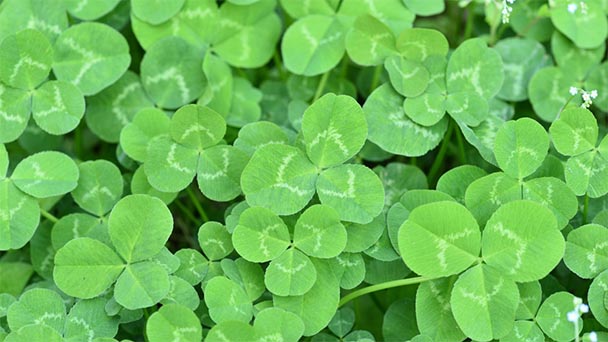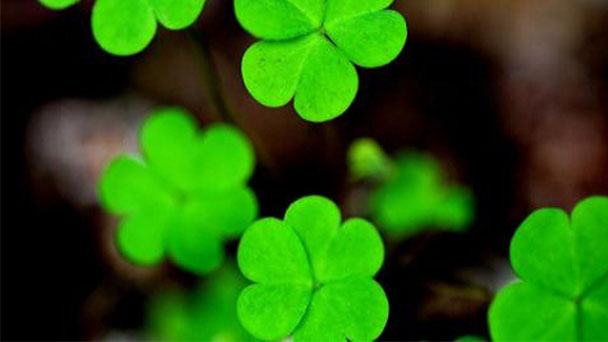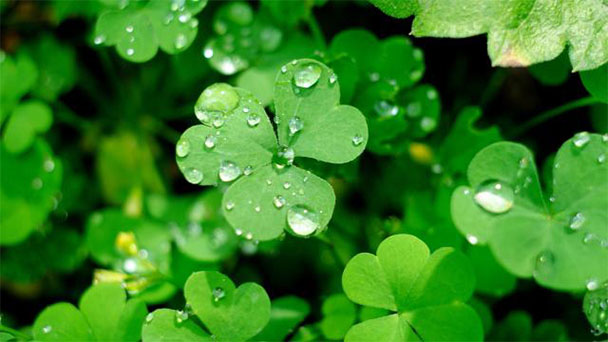Clover Profile
Written by Joy
Jan 07 2021

It is a general term for a variety of herbaceous plants with three finger-like compound leaves, mainly including three categories: leguminous trifolium (considered the most authentic clover) and alfalfa and wood sorrel in the sorrel family of certain types. In many Western countries (such as the United Kingdom, the United States) clover represents luck because it is considered a plant only found in the Garden of Eden. In some countries, the plum blossoms in playing cards represent lucky clovers. The number of clovers represents true love, health and reputation. Clover is the national flower of Ireland.


(2) The watering frequency is less, and the management is more extensive. The white clover has a well-developed root system, which can utilize the moisture in the deep layers of the soil and does not have strict requirements for dry soil moisture. Therefore, you can reduce the number of watering and extensive management.
(3) Natural renewal and long-lasting lawn. White-flowered clover does not need to be pruned, so the plant can blossom and bear fruit. The seeds grow spontaneously on the ground, which can realize natural renewal and make the lawn lasting.
(4) It is highly invasive and enjoyable. The stolons of the white flower clover spread to the surroundings, and the stem nodes are rooted on the ground. When the mother plant dies or the stem is cut, the stolons can form new independent clusters. Therefore, it is very aggressive. Clover is a broad-leaved plant with horizontally extended leaves that can effectively cover the ground and inhibit the growth of weeds. Therefore, once the white-flowered three-leaf lawn becomes a turf, weeds are not easy to invade and the lawn can be neat and beautiful.


Clover morphological characteristicsColver growth habitClover growing environment and distributionClover efficacy and roleClover cultivation
Clover morphological characteristics
Clover is a perennial herb. The plant is low, 30-40 cm high. Tap roots, the roots have the characteristics of symbiosis with rhizobia, and the roots have strong tillering ability and regeneration ability. There are many branches, creeping branches grow on the ground, roots are formed when internodes touch the ground, and new shoots sprout. Compound leaves, with three leaflets, leaflets ovate or obovate, base wedge-shaped, apex obtuse or slightly concave, edge serrated, leaf center with V-shaped white halo. Stipules are elliptical, holding stem. Flower in summer and autumn, head-shaped raceme, spherical, long total pedicel, white flowers, occasionally light red. It blooms and sets seeds at the same time. The maturity of the seeds is different, and the seeds are small.Colver growth habit
Clover has strong cold tolerance. When the temperature drops to 0°C, some old leaves are withered and the leaflets on the main root are close to the ground and stop growing, but still remain green. Therefore, the green period is very long. The soil requirements are not strict, it can adapt to various soil types and grow well on acidic soil. Prefer warm, sunny and well-drained environmental conditions. Growth is slow in drought conditions, and some die in high temperature seasons. It is resistant to trimming, trampling, and strong regeneration.Clover growing environment and distribution
Clover is mostly planted as lawn in various parks and green spaces. The seedling grows slowly. After the seeds are sown into the bed, spray every morning or evening to keep the surface of the bed moist until the seedling emerges. During this period, in addition to watering the bed to keep the bed moist, weeds must be removed at any time, mainly Manual removal to prevent weed damage. The three-leaf grassland is produced in Europe and North Africa and is cultivated all over the world. The countries with the most cultivated pasture species include Australia, New Zealand, the United Kingdom, Denmark and the Netherlands. Breeders in other countries, such as Sweden, Germany, the United States, France, Italy, Canada, and Poland, have also bred many famous varieties.Clover efficacy and role
(1) No need for construction, low management intensity. The stem of the white flower clover is stolon, the plant is low, and the height is generally between 10 and 20 cm. Therefore, the established lawn need not be mowed.(2) The watering frequency is less, and the management is more extensive. The white clover has a well-developed root system, which can utilize the moisture in the deep layers of the soil and does not have strict requirements for dry soil moisture. Therefore, you can reduce the number of watering and extensive management.
(3) Natural renewal and long-lasting lawn. White-flowered clover does not need to be pruned, so the plant can blossom and bear fruit. The seeds grow spontaneously on the ground, which can realize natural renewal and make the lawn lasting.
(4) It is highly invasive and enjoyable. The stolons of the white flower clover spread to the surroundings, and the stem nodes are rooted on the ground. When the mother plant dies or the stem is cut, the stolons can form new independent clusters. Therefore, it is very aggressive. Clover is a broad-leaved plant with horizontally extended leaves that can effectively cover the ground and inhibit the growth of weeds. Therefore, once the white-flowered three-leaf lawn becomes a turf, weeds are not easy to invade and the lawn can be neat and beautiful.
Clover cultivation
White clover seeds are very small, seedlings grow slowly, and the root system is not deep into the soil. Therefore, you must prepare the ground carefully, remove weeds, and apply sufficient base fertilizer. White clover can be sown in spring or autumn. In the north, it should be sown in spring from March to April, and in the south, it is dominated by autumn. Sowed, broadcast, aerial broadcast are all possible. The seeding rate is 0.5 kg per mu (667 m2), and the seeding depth is 1 to 1.5 cm. White clover is most suitable for mixed planting with grasses such as ryegrass, chicken foot grass, timothy grass, fescue, paspalum, oxtail grass and other pastures to establish medium and long-term grazing grassland.Latest Updated
- Benefits of Bugleweed - 7 Science-backed Health Benefits
- Bugleweed Dangers & Side Effects - Is It Poisonous?
- How to Plant Evergreen Trees - What You Should Know
- When to Plant Evergreens - Grow Guide for Evergreen Trees
- 12 Wonderful Evergreen Shrubs for Your Garden
- 12 Popular Evergreen Plants with Pictures for Beginners
- When And How To Prune A Lilac Bush Like a Pro
- How to Grow & Care for Lilac Vine (Hardenbergia Violacea)
- Japanese Lilac Tree (Syringa Reticulata) Care & Propagation Guide
- Shumard Oak Pros and Cons - What to Know
Popular Articles
- Winter maintenance of Antirrhinum Majus
- How to Grow Terminalia Mantaly Tree
- How to Grow and Care for Crossostephium Chinense
- How to grow Antirrhinum Majus in spring
- Peristeria Elata (Dove Orchid) Profile: Info & Care Guide
- Underwatered Snake Plant (Sansevieria Trifasciata) - Signs And How To Fix
- How to Care for Brazilian Jasmine Plant (Mandevilla Sanderi)
- How to Grow & Care for Graptopetalum Purple Delight in Summer
- Rosa Chinensis (China Rose): Plant Growing & Care Tips
- How to Care for Baby Sun Rose (Aptenia Cordifolia)